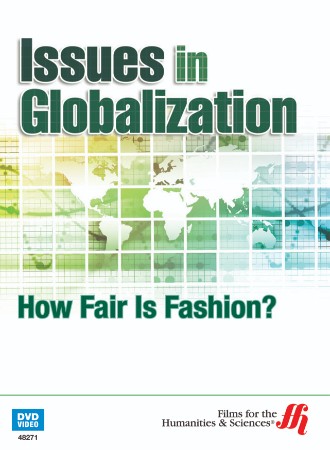
Issues in Globalization 2011
Distributed by Films Media Group, 132 West 31st St., 17th Floor, New York, NY 10001; 800-257-5126
Produced by Pumpkin Interactive Ltd.
Director n/a
DVD, color, 51 min., 2 discs
Sr. High - General Adult
Asian Studies, Business, Economics, European Studies
Date Entered: 07/11/2013
Reviewed by Michael J. Coffta, Business Librarian, Bloomsburg University of PennsylvaniaThese brief documentaries focus on globalization as it pertains to clothing production and consumption. The two installments work well together to show the grim underside of globalization’s search for cheap labor, and to offer select examples of hope that globalization can work to the benefit of all when properly managed.
Disc 1: Environmental Impacts and Sustainability
There has been massive economic growth in Bangladesh due to low wage production, but there has also been a massive amount of subsequent pollution. The film gets right to the dilemma of environmental controls driving up costs in textile factories, which often driving companies away. The generally impoverished country needs to keep these factories operational. The film summarizes the array of harmful byproducts of textile production, the water and air contamination, and the lack of enforcement of environmental controls. On a discouraging note, the filmmakers conclude that companies’ abilities to dodge regulations and increase demands outpaces and outmaneuvers Bangladesh’s governments’ abilities to legislate and enforce environmental controls. Government officials acknowledge that Bangladesh must curb its manufacturing advancements in order to ensure sustainable growth.
With a shift to the optimistic, the filmmakers draw the audience’s attention to a markedly environmentally conscious and cost effective textile factory in the UK. Similar companies are using clever strategies, including near-perpetual use of the same purified and re-purified water in a factory and treating wastes before they leave the factory. The installment concludes by stating that we the consumers need to take responsibility in order to affect companies’ environmental practices, or lack thereof.
Disc 2: How Fair is Fashion?
This installment centers on production specifics and woeful living conditions and wages that the majority of Bangladesh factory workers endure. In contrast (more than likely by design) to the first DVD, this installment exhibits trade association officials stating the need for Bangladesh, as the world’s number 3 producer of textiles by volume, to jump past Turkey and China to become the new number 1.
As with the previous DVD, there is a shift to an upbeat segment on Bangladesh workers working for certified fair trade companies, with a living wage and daycare. Again, in congruence with the first installment, the filmmakers call for companies to take the responsibility for their role in globalization and the environment.
These two DVDs work in unison as perfect counterparts to one another, in terms of content, theme, and format. This set is ideally suited for high school students, but may also serve as a reliable introductory work for more advanced audiences.